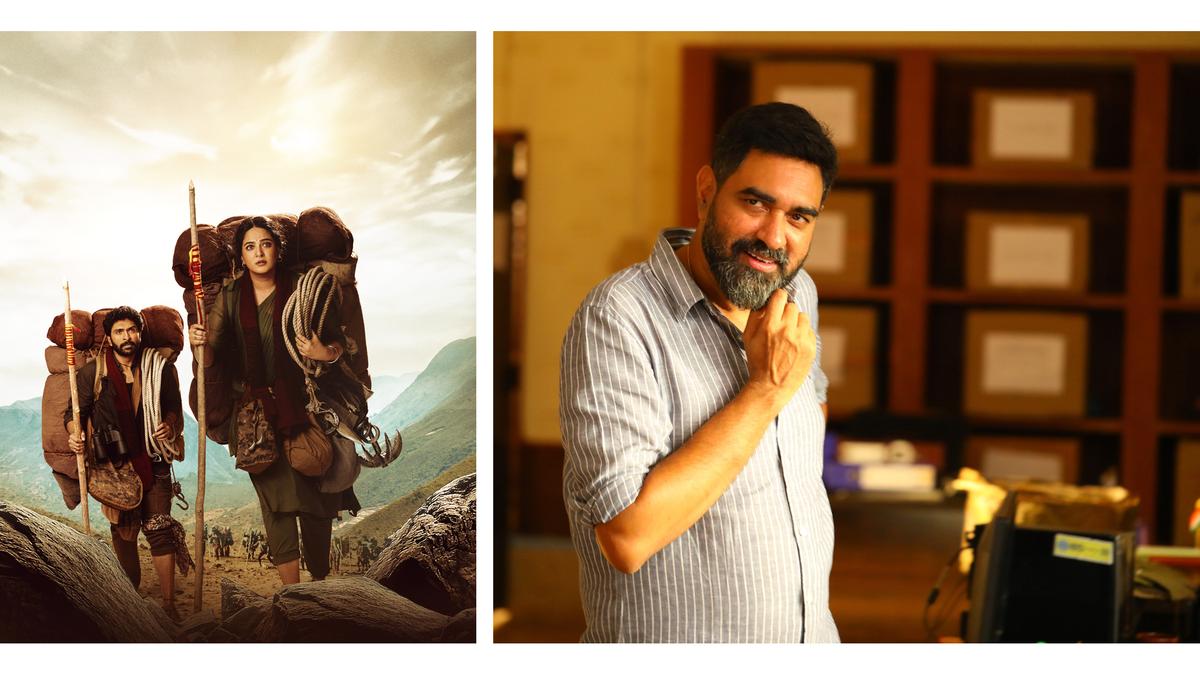The courtyards of Jaipur’s City Palace have seen plenty: royal processions, polo matches, and the shimmer of courtly patronage. This month, the palace opens its doors to a peculiar exhibition — one that asks what belonging looks like when you’ve spent years being told you don’t quite fit.
Non-Residency is presented by the Jaipur Centre for Art (JCA), a new cultural hub co-founded by Sawai Padmanabh Singh and curator Noelle Kadar to bring global conversations into the city’s historic heart. Across the world in Los Angeles, Rajiv Menon launched Rajiv Menon Contemporary in 2023 and quickly drew attention with ambitious programming and museum acquisitions. Two young institutions, two cities, one show — bringing 16 South Asian and diasporic artists together to decipher “the emotional texture” of the experience of migration, immigration, and displacement.

Rajiv Menon (centre) with Sawai Padmanabh Singh and curator Noelle Kadar
“Non-resident” is not a romantic word. In India, NRI (Non-Resident Indian) is a legal category; in the U.S., “nonresident alien” is a tax status — both ways of filing people into forms. Menon flips the chill of paperwork into something human: “For me, it was about that uncanny in-betweenness — the way the diaspora can feel both familiar and unsettling,” he says. The exhibition turns that unease into image, material, and mood. Or as he shares on the The Creative Process podcast, into an exploration of how the artists encounter their homeland from the position of the diaspora.
You feel the argument immediately in a pairing that shouldn’t work but does. Hung near visual artist Viraj Khanna’s maximalist, satirical embroideries New York-based artist Melissa Joseph’s felted works look almost whisper-quiet. Based on family photos, Joseph’s faces blur at the edges like the texture of memory over time and space. Khanna’s panels, meanwhile, riff on the social-media image economy and the theatre of the Indian wedding; they swagger into the room and then turn the mirror. Restraint and exuberance stand shoulder to shoulder, each making the other read more clearly.

Melissa Joseph’s What We Leave Behind
A few paces away, Boston artist Ricky Vasan’s Thanksgiving shrinks the epic of migration down to a table and a glance — domestic, diaristic, and disarming. San Francisco-based Anoushka Mirchandani lingers on the women in her life in quiet figurative scenes, while American-Sri Lankan artist Shyama Golden plants a flag for crisp, graphic clarity in It’s All Uphill From Here. Together, they argue that the everyday — well lit and well seen — can be as urgent as any grand narrative.

Ricky Vasan’s Thanksgiving | Photo Credit: Ruben Diaz

Anoushka Mirchandani’s art | Photo Credit: Paul Rho

Shyama Golden’s It’s All Uphill From Here

Room of sharp contrasts
Non-Residency, which encompasses paintings, sculptures and textiles, is also a conscious move away from the position of subordination that diaspora art usually finds itself in. As Menon states in the podcast, he wanted “to show that diasporic work is very much thinking in the present tense… that they’re taking their position and using it to create art that are wholly original”.
Multidisciplinary artist Kelly Sinnapah Mary taps into her Indo-Caribbean heritage with hybrid beings entangled in leaves and lore; her canvases feel like haunted herbariums that ask who gets to plant and who is allowed to grow. Jersey-based Sahana Ramakrishnan’s The People Under the Sea dives into myth and metamorphosis, braiding South Asian cosmologies with a restless eco-anxious contemporary hand.

Kelly Sinnapah Mary’s Violette’s Book: The Girl with 3 Eyes | Photo Credit: Christopher Burke Studio

Sahana Ramakrishnan’s The People Under the Sea
One thread runs across the show: texture treated as thought. Embroidery, cloth, tufting, and other material interventions within the artworks are not mere embellishments but carry as much weight as paint or sculpture. This sensibility reflects Menon’s wider ethos — one attuned to fashion and the way many young designers use craft to generate form and meaning. “Craft, clothing, art — they’ve always spoken to each other in our cultures,” he says. “I wanted the exhibition to reflect that conversation honestly.”
You see that clearly in Canadian artist Keerat Kaur’s The Source, a pomegranate overflowing with its symbols of fertility, sits comfortably in the space of painting, while Mirchandani’s translucent wisp of a woman sits sprawled in a sari, the body disappearing into the surroundings. Here, fabric, embroidery, and collage hold their own against oil and acrylic across the galleries.

A work by Rajni Perera in the group exhibition Non-Residency

Straddling both worlds
JCA also launched an artist residency alongside the show, and the first resident, San Francisco-based artist Nibha Akireddy, used her month in Jaipur to learn block printing from local artisans and spending time in the palace’s archives. Her works fold that learning straight back into the exhibition: Night Polo nods to the city’s equestrian lore, this time with lithe women as players, while Sleep Study 1 and Sleep Study 2 tuck figures into block printed sheets. Public spectacle and private tenderness, side by side — homecoming as composition rather than return.

Suchitra Mattai’s Set Free
Despite the glamour of the setting, Non-Residency refuses to become an elite parade. Yes, there are sequins and saris and saturated colour, but the curation doesn’t hide from the power structures that once dismissed these very aesthetics as unserious. The pairings are political: a high-shine Khanna beside Joseph’s hush; Ramakrishnan’s oceanic eco-mythologies interrupting a sumptuous room; Vasan’s quiet table blown to the large scale of South Asian meals. Everywhere, the hang insists that difference is not a hierarchy.

Non-Residency at Jaipur Centre for Art
For years, diasporic artists were presented as colourful exceptions to someone else’s rulebook. Non-Residency offers a cleaner sentence: let the diaspora write the rules. Stitch, blur, collage, move from the side notes they have long been rendered into. In a palace that once dictated taste, the exhibition proposes a better standard: plural, stylish, critical, and, most importantly, collective. Far from asking the diaspora to apologise for its volume, it blares it as music — tuning the room, and clearly enunciating the conversation about what Indian art can be next.
The essayist-educator writes on culture, and is founding editor of Proseterity — a literary arts magazine.

 2 hours ago
1
2 hours ago
1


















 English (US) ·
English (US) ·